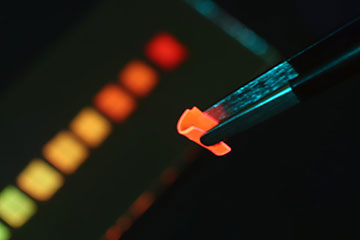
The newly developed solar concentrator when irradiated with blue LED light. The polymer material is so flexible that it can be bent with tweezers. [Image: EMPA]
Recently, luminescent solar concentrators (LSCs) have been explored as a way to enhance the power-conversion efficiency of traditional solar cells. LSCs use a transparent piece of plastic or glass embedded with luminescent molecules to re-emit light. However, LSCs developed up to this point have not been suitable for wearable applications due to rigidity or other issues.
In a new study, researchers from the Swiss Federal Laboratory for Materials Science and Technology, Switzerland, have developed a flexible, wearable LSC that paves the way for solar-powered smart clothing (Nano Energy, doi: 10.1016/j.nanoen.2020.105039).
Testing a new matrix material
While flexible LSCs have previously been created, these devices lacked certain properties that would make them truly wearable in a practical sense. For clothing applications, the matrix material that acts as a waveguide to trap the re-emitted light needs to be breathable, elastic, puncture-resistant and water-resistant.
The team of researchers, led by Luciano Boesel of the Laboratory for Biomimetic Membranes and Textiles, decided to use a matrix material that could meet these high standards. Amphiphilic polymer co-networks (APCNs) are nanostructured materials that consist of two covalently cross-linked polymers, one hydrophilic and the other hydrophobic, with nanoscale-separated domains. They are known to have robust mechanical properties that can be tailored by tuning the polymer composition and chemical functionality.
“We have been working many years already with APCNs, further developing them as functional materials to biomedical or wearable applications,” said Boesel. “APCNs are the components of silicon-hydrogel contact lenses, so it is the ideal material to use as a matrix for wearable devices or devices that should be in contact with the skin.”
Enhanced power-conversion efficiency
The researchers loaded two types of luminescent materials—the hydrophobic Lumogen Red and the hydrophilic fluorescein—into adjacent nanometer-separated domains. They autonomously form efficient energy-transfer pairs, with the Lumogen Red acting as acceptor and the fluorescein as donor. Experiments confirmed that the application of APCN films to polycrystalline silicon solar cells enhanced their power-conversion efficiency by up to 24% at certain wavelengths.
To study the behavior of re-emitted photons in APCNs, Boesel and his colleagues performed a geometry photoluminescence measurement as well as a Monte Carlo ray tracing simulation. Because APCNs can be applied as thin films to textiles, intensity losses due to travel distance would not exceed 10%. Also, the area covered by the re-emitted light is much larger than the excitation beam spot, meaning that a tandem LSC/photovoltaic device may be beneficial to the optimal utilization of incident light.
The APCN advantage
Previously, Boesel’s group functionalized APCNs with special molecules like chromophores or luminophores and looked into their use as gating materials for light-controlled transdermal drug delivery as well as chemical sensors. With these latest results, he believes that wearable LSCs can be added to the list of potential future applications for APCNs.
“In comparison to other proposed polymers used for LSC, APCNs have [advantages like] flexibility, permeation to both water vapor and oxygen, and swellability in both aqueous and organic solvents,” said Boesel. “This makes it a perfect matrix for wearable LSC.”
